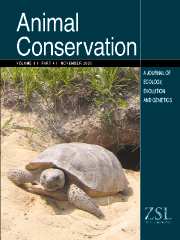Crossref Citations
This article has been cited by the following publications. This list is generated based on data provided by
Crossref.
Finlay, J. B.
Buhay, J. E.
and
Crandall, K. A.
2006.
Surface to subsurface freshwater connections: phylogeographic and habitat analyses of Cambarus tenebrosus, a facultative cave‐dwelling crayfish.
Animal Conservation,
Vol. 9,
Issue. 4,
p.
375.
MOCK, K. E.
EVANS, R. P.
CRAWFORD, M.
CARDALL, B. L.
JANECKE, S. U.
and
MILLER, M. P.
2006.
Rangewide molecular structuring in the Utah sucker (Catostomus ardens).
Molecular Ecology,
Vol. 15,
Issue. 8,
p.
2223.
Kohn, Michael H.
Murphy, William J.
Ostrander, Elaine A.
and
Wayne, Robert K.
2006.
Genomics and conservation genetics.
Trends in Ecology & Evolution,
Vol. 21,
Issue. 11,
p.
629.
STOCKMAN, AMY K.
and
BOND, JASON E.
2007.
Delimiting cohesion species: extreme population structuring and the role of ecological interchangeability.
Molecular Ecology,
Vol. 16,
Issue. 16,
p.
3374.
Zink, R. M.
2007.
Ecological exchangeability versus neutral molecular markers: the case of the great tit.
Animal Conservation,
Vol. 10,
Issue. 3,
p.
369.
de Guia, Anna Pauline O.
and
Saitoh, Takashi
2007.
The gap between the concept and definitions in the Evolutionarily Significant Unit: the need to integrate neutral genetic variation and adaptive variation.
Ecological Research,
Vol. 22,
Issue. 4,
p.
604.
Degner, Jacob F.
Stout, I. Jack
Roth, James D.
and
Parkinson, Christopher L.
2007.
Population genetics and conservation of the threatened southeastern beach mouse (Peromyscus polionotus niveiventris): subspecies and evolutionary units.
Conservation Genetics,
Vol. 8,
Issue. 6,
p.
1441.
SCHIFFER, MICHELE
KENNINGTON, W. J.
HOFFMANN, A. A.
and
BLACKET, M. J.
2007.
Lack of genetic structure among ecologically adapted populations of an Australian rainforest Drosophila species as indicated by microsatellite markers and mitochondrial DNA sequences.
Molecular Ecology,
Vol. 16,
Issue. 8,
p.
1687.
Vink, Cor J.
Sirvid, Phil J.
Malumbres-Olarte, Jagoba
Griffiths, James W.
Paquin, Pierre
and
Paterson, Adrian M.
2008.
Species status and conservation issues of New Zealand's endemic Latrodectus spider species (Araneae : Theridiidae).
Invertebrate Systematics,
Vol. 22,
Issue. 6,
p.
589.
HANSEN, BIRGITA D.
and
TAYLOR, ANDREA C.
2008.
Isolated remnant or recent introduction? Estimating the provenance of Yellingbo Leadbeater's possums by genetic analysis and bottleneck simulation.
Molecular Ecology,
Vol. 17,
Issue. 18,
p.
4039.
Johnson, Jeff A.
2008.
Recent Range Expansion and Divergence among North American Prairie Grouse.
Journal of Heredity,
Vol. 99,
Issue. 2,
p.
165.
Bond, Jason E.
and
Stockman, Amy K.
2008.
An Integrative Method for Delimiting Cohesion Species: Finding the Population-Species Interface in a Group of Californian Trapdoor Spiders with Extreme Genetic Divergence and Geographic Structuring.
Systematic Biology,
Vol. 57,
Issue. 4,
p.
628.
PHILLIMORE, A. B.
OWENS, I. P. F.
BLACK, R. A.
CHITTOCK, J.
BURKE, T.
and
CLEGG, S. M.
2008.
Complex patterns of genetic and phenotypic divergence in an island bird and the consequences for delimiting conservation units.
Molecular Ecology,
Vol. 17,
Issue. 12,
p.
2839.
Ellis, Jennifer R.
and
McCauley, David E.
2009.
Phenotypic differentiation in fitness related traits between populations of an extremely rare sunflower: Conservation management of isolated populations.
Biological Conservation,
Vol. 142,
Issue. 8,
p.
1836.
Smith, Annabel L.
Gardner, Michael G.
Fenner, Aaron L.
and
Bull, C. Michael
2009.
Restricted gene flow in the endangered pygmy bluetongue lizard (Tiliqua adelaidensis) in a fragmented agricultural landscape.
Wildlife Research,
Vol. 36,
Issue. 6,
p.
466.
Johnson, Jerald B.
Adair, Marta
Adams, Byron J.
Fairbanks, Daniel J.
Itamura, Velma
Jeffery, Duane E.
Merrell, Duane
Ritter, Scott M.
and
Tolman, Richard R.
2009.
Evolution Education in Utah: A State Office of Education–University Partnership Focuses on Why Evolution Matters.
Evolution: Education and Outreach,
Vol. 2,
Issue. 3,
p.
349.
Priddis, Edmund
Rader, Russell
Belk, Mark
Schaalje, Bruce
and
Merkley, Steven
2009.
Can separation along the temperature niche axis promote coexistence between native and invasive species?.
Diversity and Distributions,
Vol. 15,
Issue. 4,
p.
682.
Sousa, V.
Penha, F.
Pala, I.
Chikhi, L.
and
Coelho, M. M.
2010.
Conservation genetics of a critically endangered Iberian minnow: evidence of population decline and extirpations.
Animal Conservation,
Vol. 13,
Issue. 2,
p.
162.
Godsoe, William
2010.
Regional Variation Exaggerates Ecological Divergence in Niche Models.
Systematic Biology,
Vol. 59,
Issue. 3,
p.
298.
Tapio, Miika
Ozerov, Mikhail
Tapio, Ilma
Toro, Miguel A
Marzanov, Nurbiy
Ćinkulov, Mirjana
Goncharenko, Galina
Kiselyova, Tatyana
Murawski, Maziek
and
Kantanen, Juha
2010.
Microsatellite-based genetic diversity and population structure of domestic sheep in northern Eurasia.
BMC Genetics,
Vol. 11,
Issue. 1,


